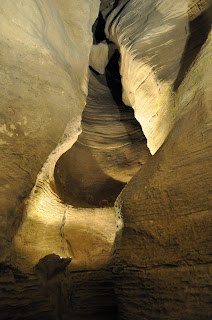 |
| A view of the apple orchard and Shaker Trustee's Building within the village. |
The 40 buildings represented three time periods during the 1800s, from the basic log construction, similar to what you'd find at Plimoth Plantation in Massachusetts, to Colonial and Victorian architecture that dotted the northeast landscape in the 19th Century. Throughout the village were costumed interpreters who provided insight into the lives of the people who would have lived in small villages during that time. The buildings were purchased, disassembled and moved here from other parts of New York state, and then reconstructed into a single historic village.
The entrance to the museum was a modern visitor center where we paid the fee of $15.50 per adult and $9.50 for Ashton.
After we purchased our ticket, we crossed an expansive green lawn, passing a tall bandstand to the Toll House where we entered the historic village.
One of our first stops was the one-room schoolhouse where Ashton wrote on a slate and heard about what children would learn in their lessons way back then.
 |
| Brewery and Hop House |
 |
| Turning pottery at Flint Hill Pottery |
stoneware. Now this is a product made on-sight that you can also buy in the gift shop, so we purchased a small pitcher for coffee cream.
We visited every building that was open including the tinsmith shop, blacksmith shop, cooper shop, gunsmith shop and innumerable houses. We also gave walking on stilts a go.
Seeing all the buildings probably took about 2-3 hours including a break for lunch. For those interested in riding around the village, there was a wagon pulled by a farm tractor. Only one was running that day, so if you wanted to use it to move from one place to another within the village, you had to have patience, as the tractor pulling the wagon had one speed - slow.
Another one of our favorite stops was Hosmer's Inn. The interpreter there did a great job making us aware of appropriate inn etiquette. He explained that the women and men had different rooms in which to socialize and talked about the costs of the rooms, pointing out that save money buy opting for a room without a bed. This essentially just gave you a feather mattress on the floor and a blanket.
It was an interesting place that was reasonably priced, so we would recommend a visit for anyone interested in history.

 |
| Ashton in the meeting house |
 |
| Hamilton House |
 |
| Newspaper shop viewed from in front of Hosmer's Inn |











